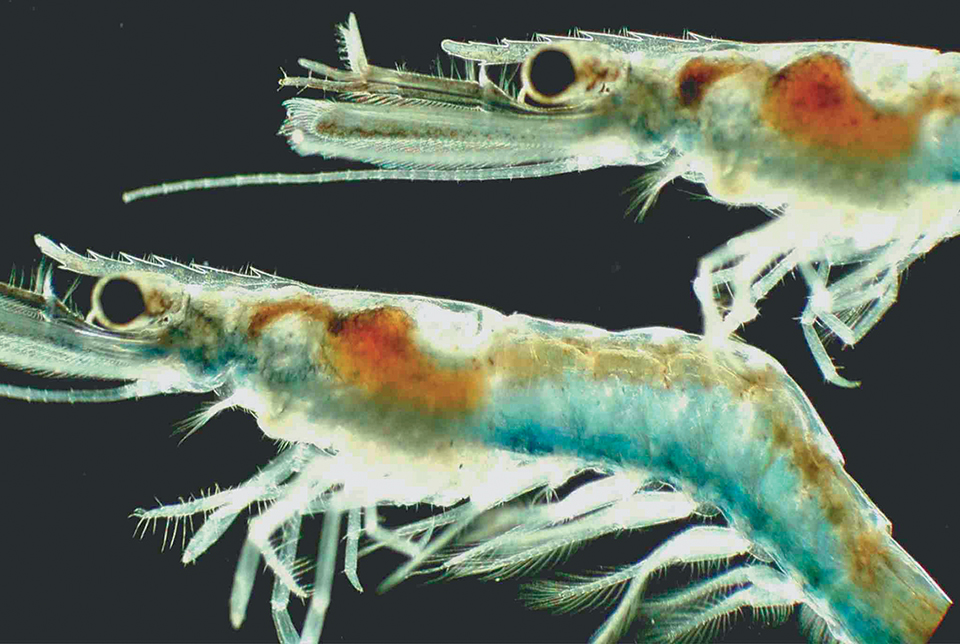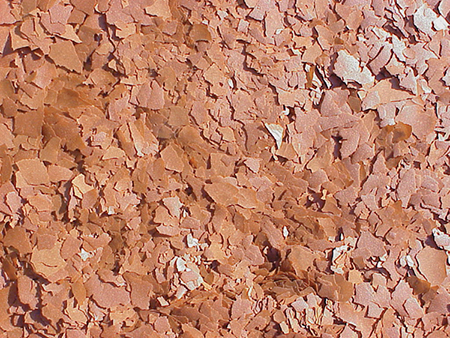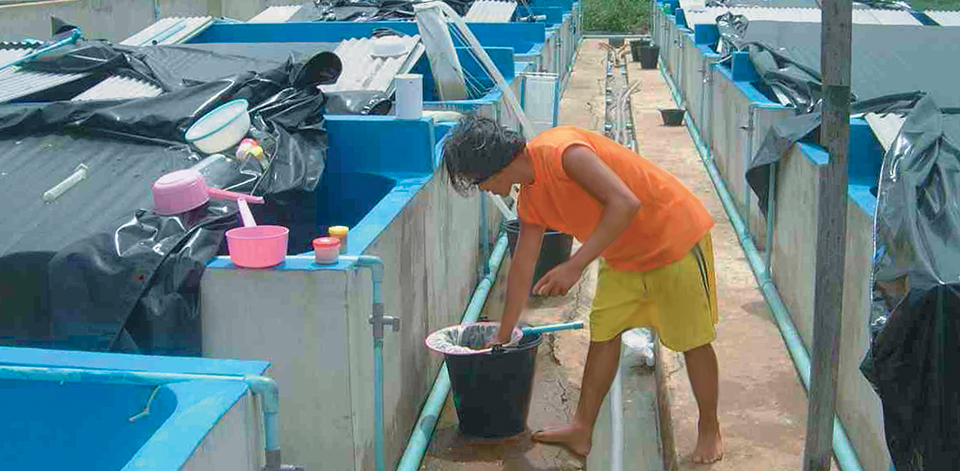Feed flakes with a balanced nutritional composition can replace majority of artemia

Stage PL14 Penaeus monodon fed high-end flakes. Photo by Peter Bridson.Shrimp postlarvae (PLs) can be fed entirely on artificial diets, though the best growth rates are generally obtained when feeds include artemia or enriched artemia. Since dependence on brine shrimp is of concern to the hatchery industry, reduced use of brine shrimp cysts was reported during 2000-2001. Combined with the use of inadequate replacement diets, this resulted in cases of low survival and poor seedstock quality.
Significant efforts have since been devoted to develop cost-effective diets that meet the nutritional requirements of larvae and postlarvae and also consider the important issues of feed intake, digestibility, leaching, water stability and biosecurity.
Flake technology

Among artificial diets for shrimp PLs, flakes have received considerable interest from the industry and are now commonly available in the markets of Asia and the Americas. The technology to manufacture flakes is straightforward.
The ingredients are milled or pulverized and added to water to obtain a dense soup. After an appropriate binder is added, the suspension is mixed thoroughly and pumped over a flaker, which is usually a steam drum dryer. The resulting flakes are passed through a mesh screen that can be adjusted according to the desired particle size appropriate to the desired postlarval stage.
Nutritional flakes
Flaking offers several advantages over extrusion. For example, the starch level does not need to be elevated, which presents an opportunity to formulate with extra-high levels of marine proteins and supplements of essential nutrients. Additionally, the temperature/time exposure of the feed mash with a steam drum is more nutrient-friendly than with a classic extruder.
This is the concept for “nutritional flakes,” which are high-end flakes with an elevated nutritional value. It is pertinent to note, however, that some currently available commercial flakes are designed as low-end products and have a limited capacity to replace artemia.
Flake processing and feeding
Nutritional flakes can be produced using several techniques. The classic technique uses a drum dryer where the feed suspension is fed to the surface of the drum. Product temperature can reach 125 degrees-C and cause significant quality loss.
An innovative technique using a Refractance Window™ dryer was developed by the United States company MCD Technologies Inc. This method removes moisture gently from the feed suspension and prevents the feed from reaching high temperatures. The retention of heat-sensitive nutrients is comparable to the retention for freeze-dried products and much higher than for drum-dried products.
The process preserves both color and flavor. Table 1 compares the levels of highly unsaturated fatty acids and heat-sensitive vitamins in flakes produced using both processing techniques. The data show a better retention of these nutrients with the low-temperature technology.
Wouters, Levels of essential nutrients upon processing, Table 1
| Nutrient | Drum-Dried (% Dry Matter) | Low Temperature (% Dry Matter) | Difference (%) |
|---|---|---|---|
| EPA | 0.89 | 1.00 | +12 |
| DHA | 1.48 | 1.71 | +13 |
| Vitamin A | 0.00144 | 0.00152 | +6 |
| Vitamin E | 0.1388 | 0.1296 | -7 |
| Vitamin C | 0.1326 | 0.1904 | +44 |
Shrimp culture performance

The performance of both flake types was tested in May 2001 at the IATEC research center in the Chachoengsao Province of Thailand. A large-scale setup with tanks of 2,500 liters was used under typical commercial conditions for Penaeus monodon. Three replicate tanks were stocked with 75 PL per liter in each treatment. Evaluation variables were collected after a 15-day period.
Results showed that a 40 percent replacement of artemia with flakes made by the low-temperature technique improved the growth rate of P. monodon PL (P < 0.05) (Fig. 1). Survival, which was 80 percent or above in all treatments, did not differ significantly among treatments.
The biological value of flakes produced by the low-temperature technique was higher than that of classic flakes. Both animal dry weight (P < 0.05) and survival (P > 0.05) were higher with the low-temperature flakes. This improved performance is likely related to better retention of essential nutrients and flavor.
This commercial-scale test did not include artemia replacement levels above 40 percent. In preliminary small-scale tests, however, replacement levels of 65 to 100 percent gave excellent results. Thus, nutritional flakes can be a valuable alternative for shrimp hatchery managers to reduce dependence on live food, thus simplifying protocols and reducing costs.
Conclusion
Feed flakes with a balanced nutritional composition can replace most of the live artemia nauplii typically used in the culture of shrimp postlarvae. The innovative Refractance Window™ flaking process improved the quality and performance of the flakes over those made by drum drying.
(Editor’s Note: This article was originally published in the December 2002 print edition of the Global Aquaculture Advocate.)
Now that you've finished reading the article ...
… we hope you’ll consider supporting our mission to document the evolution of the global aquaculture industry and share our vast network of contributors’ expansive knowledge every week.
By becoming a Global Seafood Alliance member, you’re ensuring that all of the pre-competitive work we do through member benefits, resources and events can continue. Individual membership costs just $50 a year. GSA individual and corporate members receive complimentary access to a series of GOAL virtual events beginning in April. Join now.
Not a GSA member? Join us.
Authors
-
Roeland Wouters, Ph.D.
INVE Technologies NV
Project Group Larval Shrimp Nutrition
Oeverstraat 7, B-9200
Baasrode, Belgium[101,98,46,101,118,110,105,64,115,114,101,116,117,111,119,46,114]
-
T. Van Horenbeeck
INVE Technologies NV
Project Group Larval Shrimp Nutrition
Oeverstraat 7, B-9200
Baasrode, Belgium -
G. Merchie, Ph.D.
INVE Technologies NV
Project Group Larval Shrimp Nutrition
Oeverstraat 7, B-9200
Baasrode, Belgium
Related Posts

Aquafeeds
Animal protein meals reduce feed costs but don’t improve shrimp performance
The authors conducted a study to determine how replacement of salmon meal with various animal protein meals in feed affected the growth performance of white shrimp.

Health & Welfare
Brazil’s intensive shrimp nursery systems improve PL management, grow-out ponds
Intensive nursery systems are an extension of hatcheries to acclimate postlarvae to farm conditions and assess quality and health prior to pond stocking.

Health & Welfare
Economic analyses project rising returns for intensive biofloc shrimp systems
In trials raising larger juvenile shrimp than those used previously in indoor super-intensive recirculating raceway systems, the positive effects from increased stocking size, growth rate and survival resulted in a reduced crop duration time.

Health & Welfare
Genetic markers help track soy protein utilization in shrimp
Recent research by the authors discovered genetic markers for the identification of Pacific white shrimp with enhanced capability to convert soy protein in feed.


